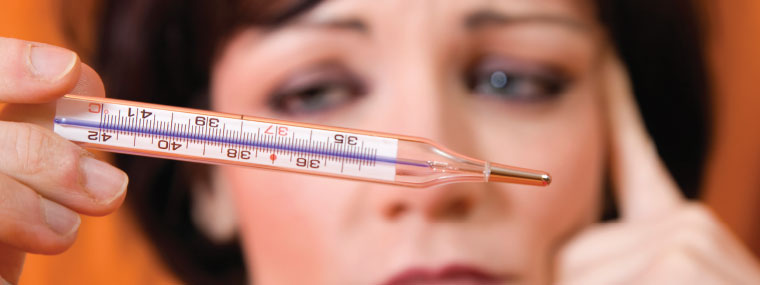
Minimizing the “Communicable” in Communities
by Kathy Danforth / Published February 2015

Shared joys and shared germs are both part of living in a community. Preventing the spread of communicable diseases in common areas is much like disaster preparation: steady, ongoing effort with the optimum outcome being nothing to report. Out-breaks of influenza, MRSA, and high-impact diseases such as Ebola are a reminder that preventive cleaning and disinfecting measures should already be routine. Cleaning for aesthetics is pleasant, but the conscientious cleaning, sanitizing, and disinfecting of frequently touched surfaces is part of the basic protection of residents and guests.
Dain Weister, Public Information Officer with the Florida Department of Health for Orange and Seminole Counties, states that MRSA, Norovirus (acute gastroenteritis), and flu are illnesses that are easily spread in condominium or HOA common areas. “Any type of virus or bacteria can spread in these settings just as it can in any facility that has surfaces. How long a virus or bacteria can survive on a surface varies, but some can live up to 24 hours. To kill these germs, the best cleaners will have bleach, but any cleaners are helpful,” he relates.
The CDC distinguishes between cleaners or detergents, sanitizers, and disinfectants. Cleaners and detergents target dirt and germs by lifting the germs and grime off the surface and rinsing it away, similar to handwashing. This routine cleaning removes pathogens and may also be necessary for sanitizers or disinfectants to effectively make contact with remaining germs. Sanitizers reduce the number of germs on a surface, while disinfectants kill or deactivate germs but do not remove them. Weister observes, “The places where germs are most likely to be passed along are doorknobs, elevator buttons, phones, public keyboards, keypads, fitness equipment controls, and any place in the community that people frequently touch.” Some of these areas are difficult to clean or may be easily damaged by chemicals and water; they may need a cleanable cover or skin to enable cleaning.
According to the CDC (www.cdc.gov/mrsa/community/environment/index.html), “Large surfaces such as floors and walls have not been directly associated in the spread of staph and MRSA. There is no evidence that spraying or fogging rooms or surfaces with disinfectants will prevent MRSA infections more effectively than the targeted approach of cleaning frequently-touched surfaces and any surfaces that have been exposed to infections.”
Associations with fitness equipment have additional surfaces in contact with various individuals. “Fitness equipment should be cleaned after each use,” Weister recommends, “but, at the least, it should be cleaned once each day.” Any open sores should be kept bandaged to avoid contact with equipment.
Despite the association’s regular cleaning, residents should treat common areas as public areas when it comes to self-protection. Barriers such as towels, clothing, or tissues can be used between skin and surfaces, which may be contaminated. “We stress extraordinary hygiene,” Weister advises. “Washing hands is very important, especially after touching keypads, doors, and elevator buttons. Soap and hot water is always best, and we recommend scrubbing for the time it takes to sing ‘Happy Birthday.’ Hand sanitizer with 60 percent alcohol is very helpful, but it doesn’t match washing your hands to get rid of germs.”
While winter weather brings flu, Weister says, “I don’t know that there’s one time of the year that is worse than the others for infectious diseases. It’s just different bugs for different times of the year.”
“In the summer, we see more recreational water illnesses,” according to Weister. In addition to proper pool maintenance, associations should promote policies to minimize the spread of disease at the pool area. “We recommend a shower with soap before entering the pool, especially if the swimmer has been very active just prior to swimming. No one who has diarrhea or is ill should go in the water,” Weister cautions. “Children should not wear a diaper in the pool, and diapers should be changed in the bathroom—not at the pool’s side where germs can get into the water. Children should have frequent bathroom breaks and wash their hands before re-entering the pool. No one should get pool water in their mouth, especially children.”
Another potential source of disease transmission is through HVAC and water systems. “Legionnaires’ disease is caused by the Legionella bacteria that can be found naturally in the environment, particularly in the type of warm water found in hot tubs, cooling towers, hot water tanks, large plumbing systems, or parts of the air-conditioning systems found in large buildings. It is important to know that it cannot be spread person-to-person. People contract Legionnaires’ disease when they breathe in a mist or vapor that has been contaminated with bacteria. One example might be from breathing in the steam from a whirlpool spa that has not been properly cleaned and disinfected,” Weister explains.
A number of diseases must be reported by doctors for public health reasons, and if there is a health threat, the association will be notified. (The list of those diseases can be found at www.floridahealth.gov/diseases-and-conditions/disease-reporting-and-management/_documents/reportable_diseases/_documents/Reportable_Diseases_List_Practitioners.pdf.) “When the Florida Department of Health investigates reportable disease cases or outbreaks, recommendations are made to potentially impacted facilities so that they can take action to reduce the risk of disease transmission,” Weister notes. “This may include environmental cleaning. The Florida Department of Health protects the health information of individuals and follows HIPAA. We do this notification only if there is a case of concern.”
Associations will want to control the spread of even minor illnesses like colds, though, and those measures will also combat the more threatening diseases. Regular cleaning to remove germs may not even produce a visible result after cleaning, but when you can see that germs have spread, it’s too late. The challenge for associations is maintaining diligence in the daily, mundane battle against the unseen viruses and bacteria that can threaten the health of vulnerable residents.

